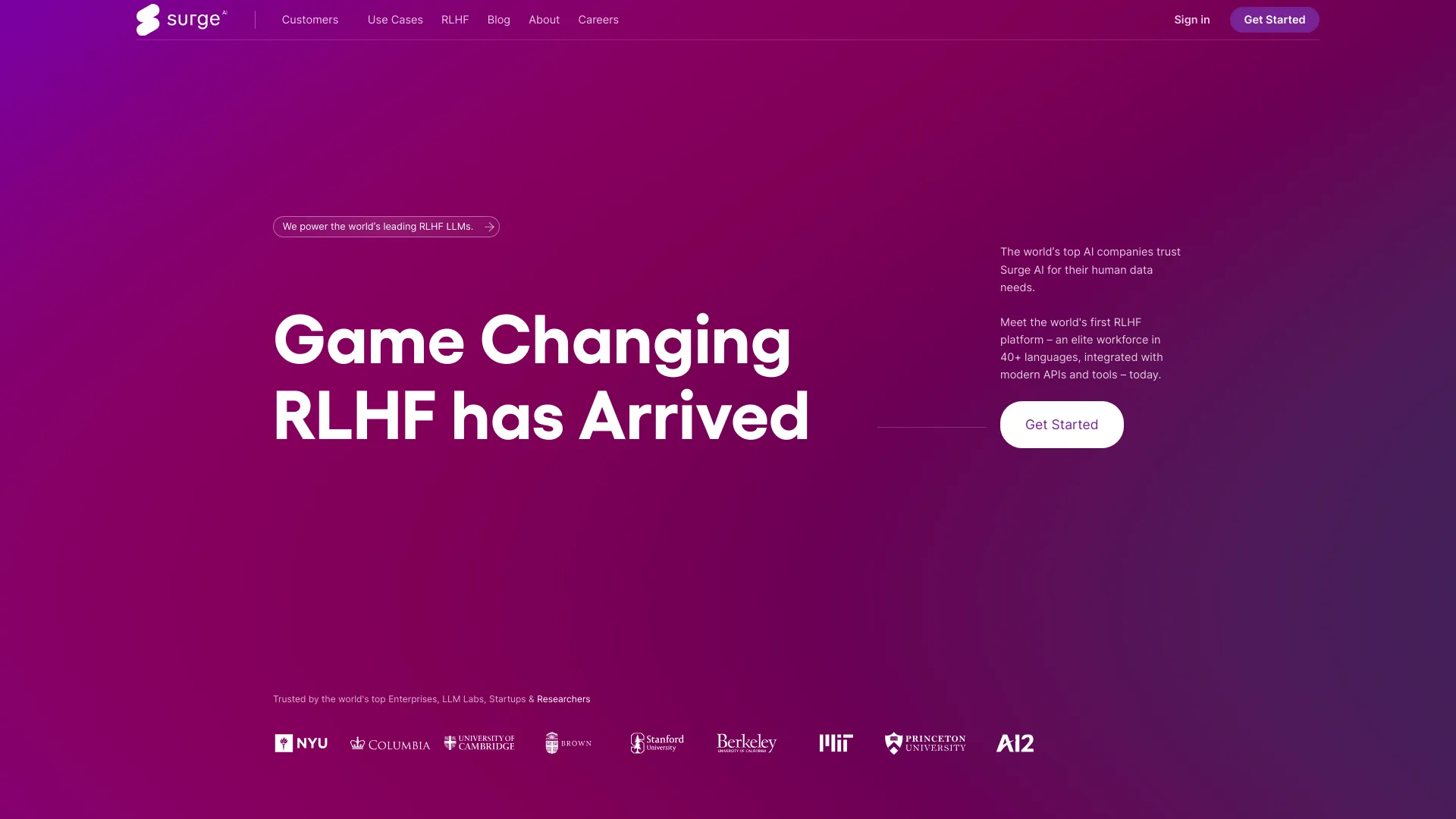
Surge AI
Open Website-
Tool Introduction:High-quality AI data labeling with RLHF, SFT, secure APIs, 24/7.
-
Inclusion Date:Oct 28, 2025
-
Social Media & Email:
Tool Information
What is Surge AI
Surge AI is a data labeling platform and managed workforce built for training modern generative AI systems. It delivers high-quality human annotations for Supervised Fine-Tuning (SFT), Reinforcement Learning with Human Feedback (RLHF), and human evaluation, supporting use cases like content moderation, search ranking, and next‑gen command LLMs. With enterprise-grade security, scalable talent operations, and API/SDK integration, Surge AI helps teams produce reliable training data, iterate on prompts and policies, and accelerate model deployment with 24/7 global support and managed service options.
Surge AI Main Features
- SFT data creation: Curates instruction–response pairs, task-specific datasets, and edge cases that improve fine-tuned LLM performance.
- RLHF pipelines: Collects preference rankings and feedback for reward modeling and policy optimization.
- Human evaluation: Performs systematic evaluations of model outputs for quality, safety, and relevance.
- Content moderation labeling: Builds robust policy-aligned datasets for safety, trust, and compliance workflows.
- Search and ranking judgments: Generates human relevance labels for query–document pairs to boost retrieval quality.
- Enterprise-grade security: Controls, auditability, and processes designed for regulated and large-scale environments.
- API & SDK integration: Launch tasks, stream results, and automate QA directly within your ML pipelines.
- Managed service & workforce: Expert project management, custom guidelines, and specialized annotators at scale.
- Quality assurance: Multi-rater reviews, gold standards, and calibration to maintain consistency and accuracy.
- 24/7 global support: Around-the-clock communication to keep projects moving across time zones.
Who Should Use Surge AI
Surge AI suits machine learning teams building LLMs, product owners shipping AI features, trust & safety and policy teams, search/recommendation engineers, and enterprises that require secure, audited data operations. It also fits labs iterating on SFT/RLHF, startups training command models, and companies needing ongoing human evaluation to monitor model quality in production.
How to Use Surge AI
- Define your objectives (SFT, RLHF, moderation, evaluation) and target quality metrics.
- Scope data types, labeling schema, guidelines, and volume with the Surge AI team.
- Integrate via API/SDK or set up a managed project with custom workflows.
- Run pilot tasks to calibrate instructions, gold standards, and QA criteria.
- Launch full-scale labeling with monitoring, sampling, and reviewer feedback loops.
- Review analytics and quality reports; refine prompts, policies, or schemas as needed.
- Ingest results into your training/evaluation pipelines and iterate.
Surge AI Industry Use Cases
In e-commerce, teams use Surge AI to label query–product relevance and user intent, improving search ranking and recommendations. Social and community platforms rely on policy-aligned moderation datasets to reduce harmful content and enforce nuanced safety rules. Enterprise AI assistants benefit from SFT instruction datasets and RLHF preference signals to enhance task following and tone. R&D groups deploy human evaluation to compare model variants, diagnose failure modes, and monitor quality drift over time.
Surge AI Pricing
Pricing is typically scoped to project needs such as task complexity, domain expertise, volume, QA depth, and service level (API-driven vs. fully managed). For accurate rates, contract terms, and enterprise options, contact Surge AI’s team to obtain a tailored quote aligned with your workloads and compliance requirements.
Surge AI Pros and Cons
Pros:
- Specialized workforce for SFT, RLHF, and nuanced human evaluation.
- Enterprise-grade security and operational rigor for sensitive data.
- API/SDK integration that fits into modern ML and MLOps pipelines.
- Robust QA processes with calibration, gold standards, and multi-rater checks.
- Scales from pilot studies to large, ongoing production programs.
- 24/7 global support and managed service reduce operational overhead.
Cons:
- Higher cost than self-serve crowdsourcing for simple, low-stakes tasks.
- Human-in-the-loop workflows add coordination and lead time.
- Data transfer and compliance reviews may lengthen onboarding in regulated sectors.
- Custom guidelines require careful iteration to reach target quality.
- Vendor lock-in risk if pipelines depend heavily on proprietary workflows.
Surge AI FAQs
-
What types of data can Surge AI label?
Text-focused tasks are common (instructions, dialogues, policy judgments, relevance), with support for structured annotations, rankings, and evaluations used in SFT, RLHF, and moderation.
-
How does RLHF work with Surge AI?
Surge AI collects human preference data (e.g., pairwise or listwise rankings) to train reward models and guide policy optimization, improving model helpfulness, safety, and adherence.
-
Can we integrate via API or SDK?
Yes. You can programmatically create tasks, fetch results, and automate QA to keep data flowing into your training pipelines.
-
How is quality measured and maintained?
Through calibration rounds, gold standards, spot checks, multi-rater agreement, and continuous feedback to annotators and guidelines.
-
Does Surge AI support enterprise security requirements?
It emphasizes enterprise-grade security and managed controls suitable for large organizations and regulated use cases.





